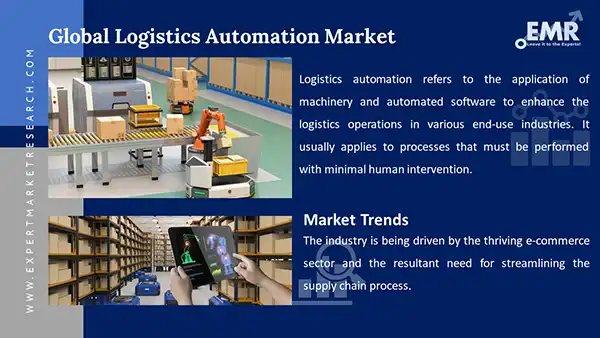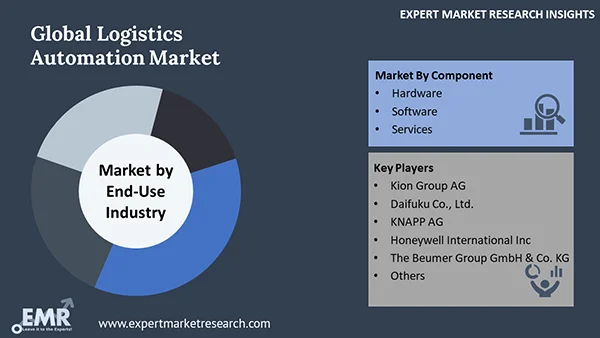
Consumer Insights
Uncover trends and behaviors shaping consumer choices today
Procurement Insights
Optimize your sourcing strategy with key market data
Industry Stats
Stay ahead with the latest trends and market analysis.
The global logistics automation market attained a value of about USD 84.07 Billion in 2025. The market is further expected to grow at a CAGR of 13.20% during the forecast period of 2026-2035 to reach approximately USD 290.47 Billion by 2035.
Base Year
Historical Period
Forecast Period
Compound Annual Growth Rate
13.2%
Value in USD Billion
2026-2035
*this image is indicative*
The market for logistics automation in various end-use industries including manufacturing, and the food and beverage industry, is propelling due to the rapidly changing business dynamics with the integration of the latest technologies. The deployment of robotics to transfer products from one location to another enhances productivity by eliminating repetitive and mundane tasks, thereby minimising manual labour, and reducing operational costs.

Read more about this report - REQUEST FREE SAMPLE COPY IN PDF
Therefore, the demand for logistics automation is rising. Furthermore, manufacturing practices like using raw materials to achieve flexibility and durability, along with compact manufacturing designs, is augmenting the market growth for logistics automation. In addition to this, with the introduction of software like Artificial Intelligence (AI) and Internet of Things (IoT) technology, features such as remote management of robots, voice commands, and real-time tracking of the robots are further enhancing the industry demand for logistics automation.

Read more about this report - REQUEST FREE SAMPLE COPY IN PDF
Logistics automation refers to the application of machinery and automated software to enhance the logistics operations in various end-use industries. It usually applies to processes that must be performed with minimal human intervention.
The market, on the basis of component, can be segmented into:
The hardware segment can be further divided into mobile robots (AGV, AMR), automated storage and retrieval systems (AS/RS), automated storing systems, de-palletising/ palletising systems, conveyor systems, automatic identification and data collection (AIDC), and order picking.
Based on end-use industry, the market can be classified into:
Based on region industry, the market can be classified into:
The rising prevalence of e-commerce retail is bolstering the market growth for logistics automation systems in warehouse management and for streamlining the supply chain process. E-commerce is gaining prominence in developing nations owing to the expansion of established websites like Amazon. The outburst of coronavirus has further led to the development of e-commerce in nearly every part of the world so that human contact and the chances of contracting the virus could be minimised, thus flourishing the demand for the latest technological adaption. The e-commerce boom has laid emphasis on efficient sorting, especially in parcel operations, due to the diversity in the product line. Hardware components like conveyor systems, coupled with barcode scanning, can aid in assortment and segregation based on various factors, and hence enhance delivery operations. In addition, computerised technology can also boost productivity by speeding up the process, reduce human errors, and improve accuracy. Furthermore, owing to rising health concerns to reduce the risk of infection, robotic technology is increasingly being deployed to diminish human intervention, thereby aiding the market growth.
The report presents a detailed analysis of the following key players in the global logistics automation market, looking into their capacity, market share, and latest developments like capacity expansions, plant turnabouts and mergers and acquisitions.
The comprehensive report looks at the micro and macro aspects of the industry. The EMR report gives an in-depth insight into the market by providing a SWOT analysis as well as an analysis of the Porter’s Five Forces Model.




*While we strive to always give you current and accurate information, the numbers depicted on the website are indicative and may differ from the actual numbers in the main report. At Expert Market Research, we aim to bring you the latest insights and trends in the market. Using our analyses and forecasts, stakeholders can understand the market dynamics, navigate challenges, and capitalize on opportunities to make data-driven strategic decisions.*
Get in touch with us for a customized solution tailored to your unique requirements and save upto 35%!
The market attained a value of approximately USD 84.07 Billion in 2025.
The market is projected to grow at a CAGR of 13.20% in the forecast period of 2026-2035.
The market is estimated to witness healthy growth in the forecast period of 2026-2035 to reach about USD 290.47 Billion by 2035.
The major drivers of the market include the increasing deployment of logistics automation to enhance productivity and reduce operational costs, and the integration of technology like AI and IoT.
The key trends in the market include the thriving e-commerce sector and rising globalisation surging the demand for streamlined supply chain processes.
The major regional markets for logistics automation are North America, Latin America, the Asia Pacific, Europe, and the Middle East and Africa.
The different components of logistics automation include hardware, software, and services.
The major end-use industries of logistics automation are food and beverage, post and parcel, groceries, general merchandise, apparel, and manufacturing, among others.
The key players in the global logistics automation market are Kion Group AG, Daifuku Co., Ltd., KNAPP AG, Honeywell International Inc, and The Beumer Group GmbH & Co. KG, among others.
Explore our key highlights of the report and gain a concise overview of key findings, trends, and actionable insights that will empower your strategic decisions.
| REPORT FEATURES | DETAILS |
| Base Year | 2025 |
| Historical Period | 2019-2025 |
| Forecast Period | 2026-2035 |
| Scope of the Report |
Historical and Forecast Trends, Industry Drivers and Constraints, Historical and Forecast Market Analysis by Segment:
|
| Breakup by Component |
|
| Breakup by End-Use Industry |
|
| Breakup by Region |
|
| Market Dynamics |
|
| Competitive Landscape |
|
| Companies Covered |
|
| Report Price and Purchase Option | Explore our purchase options that are best suited to your resources and industry needs. |
| Delivery Format | Delivered as an attached PDF and Excel through email, with an option of receiving an editable PPT, according to the purchase option. |
Datasheet
One User
USD 2,499
USD 2,249
tax inclusive*
Single User License
One User
USD 3,999
USD 3,599
tax inclusive*
Five User License
Five User
USD 4,999
USD 4,249
tax inclusive*
Corporate License
Unlimited Users
USD 5,999
USD 5,099
tax inclusive*
*Please note that the prices mentioned below are starting prices for each bundle type. Kindly contact our team for further details.*
Flash Bundle
Small Business Bundle
Growth Bundle
Enterprise Bundle
*Please note that the prices mentioned below are starting prices for each bundle type. Kindly contact our team for further details.*
Flash Bundle
Number of Reports: 3
20%
tax inclusive*
Small Business Bundle
Number of Reports: 5
25%
tax inclusive*
Growth Bundle
Number of Reports: 8
30%
tax inclusive*
Enterprise Bundle
Number of Reports: 10
35%
tax inclusive*
How To Order

Select License Type
Choose the right license for your needs and access rights.

Click on ‘Buy Now’
Add the report to your cart with one click and proceed to register.

Select Mode of Payment
Choose a payment option for a secure checkout. You will be redirected accordingly.
Gain insights to stay ahead and seize opportunities.

Get insights & trends for a competitive edge.

Track prices with detailed trend reports.

Analyse trade data for supply chain insights.

Leverage cost reports for smart savings

Enhance supply chain with partnerships.

Connect For More Information
Our expert team of analysts will offer full support and resolve any queries regarding the report, before and after the purchase.
Our expert team of analysts will offer full support and resolve any queries regarding the report, before and after the purchase.
We employ meticulous research methods, blending advanced analytics and expert insights to deliver accurate, actionable industry intelligence, staying ahead of competitors.
Our skilled analysts offer unparalleled competitive advantage with detailed insights on current and emerging markets, ensuring your strategic edge.
We offer an in-depth yet simplified presentation of industry insights and analysis to meet your specific requirements effectively.
Share